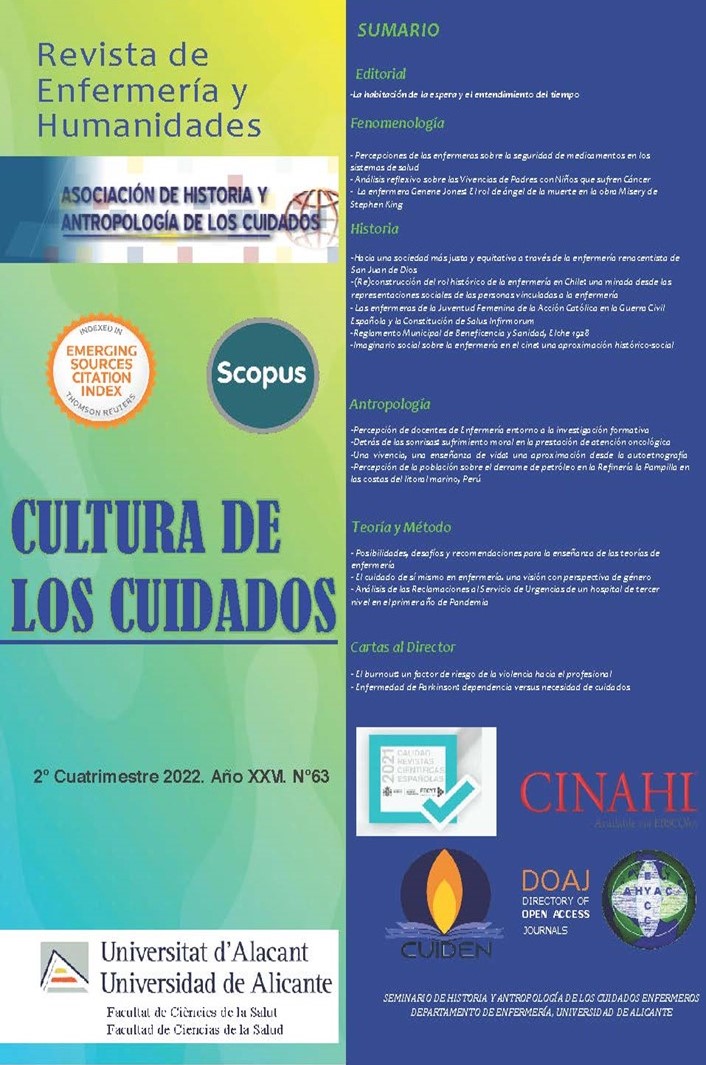Una vivencia, una enseñanza de vida: una aproximación desde la autoetnografía
DOI:
https://doi.org/10.14198/cuid.2022.63.12Palabras clave:
Síndrome de Down, autoetnografía, enfermería neonatal, familia, investigación cualitativaResumen
Teniendo como punto de partida mi experiencia personal y profesional, en el marco de la escritura y el análisis autoetnográfico que he desarrollado, como el objeto de estudio para mi tesis doctoral. He compilado algunas situaciones vividas relevantes que han estado ahí. Algunas de ellas, evidentes y otras ocultas en el tiempo, que me han permitido darme libertad para interrogarme ahora como hombre, profesional y como padre, constituyéndose de esa forma en la raíz de una parte de mi trabajo de tesis doctoral. El formarme y dedicarme como enfermero neonatal, además de la experiencia de ser padre de un hijo con Síndrome de Down, me ha posibilitado brindar apoyo a familias de recién nacidos con diagnóstico de Síndrome de Down, através de mi propia experiencia. En esta narración dejo ver, las posibles interacciones que pueden surgir entre una familia y los profesionales en salud ante una situación difícil.
Citas
Anderson, W. G., Puntillo, K., Cimino, J., Noort, J., Pearson, D., Boyle, D., Grywalski, M., Meyer, J., O’Neil-Page, E., Cain, J., Herman, H., Barbour, S., Turner, K., Moore, E., Liao, S., Ferrell, B., Mitchell, W., Edmonds, K., Fairman, N., Pantilat, S. Z. (2017). Palliative Care Professional Development for Critical Care Nurses: A Multicenter Program. American Journal of Critical Care: An Official Publication, American Association of Critical-Care Nurses, 26(5), 361-371. https://doi.org/10.4037/ajcc2017336
Anton, F. (2013). Aproximación antropológica a la seguridad en las sociedades complejas. Universitas, XI(19), 73-100.
Antonucci, M. (2018). Cuerpos Liminales: La incertidumbre del médico y del paciente en los casos pre-diagnósticos de esclerosis múltiple [Universitat de Barcelona]. file:///C:/Users/HP450-%20PC/Desktop/autoetnografia%20enfermedad/2018%20Manuela_Antonucci.pdf
Bochner, A. P. (1997). It’s About Time: Narrative and the Divided Self. Qualitative Inquiry, 3(4), 418-438. https://doi.org/10.1177/107780049700300404
Boykin, A., & Schoenhoffer, S. (Eds.). (2015). Theory of nursing as caring. En Nursing theories & nursing practice (Fourth edition, pp. 341-356). F.A. Davis Company.
Buller, H., Virani, R., Malloy, P., & Paice, J. (2019). End-of-Life Nursing and Education Consortium Communication Curriculum for Nurses. Journal of Hospice & Palliative Nursing, 21(2), E5-E12. https://doi.org/10.1097/NJH.0000000000000540
Choi, H., Van Riper, M., & Thoyre, S. (2012). Decision Making Following a Prenatal Diagnosis of Down Syndrome: An Integrative Review. Journal of Midwifery & Women’s Health, 57(2), 156-164. https://doi.org/10.1111/j.1542-2011.2011.00109.x
Fitzpatrick, J. J. (2017). Narrative Nursing: Applications in Practice, Education, and Research. Applied Nursing Research, 37, 67. https://doi.org/10.1016/j.apnr.2017.08.005
Fitzpatrick, J. J. (2018). Teaching Through Storytelling: Narrative Nursing. Nursing Education Perspectives, 39(2), 60-60. https://doi.org/10.1097/01.NEP.0000000000000298
Friedersdorf, C. (2017, octubre 30). «I Am a Man With Down Syndrome and My Life Is Worth Living». The Atlantic. https://www.theatlantic.com/politics/archive/2017/10/i-am-a-man-with-down-syndrome-and-my-life-is-worth-living/544325/
Garro, L. C. (2002). Hallowell’s challenge: Explanations of illness and cross-cultural research. Anthropological Theory, 2(1), 77-97. https://doi.org/10.1177/1463499602002001289
Gómez, O., & Gutíerrez. (2011). La situación de enfermería: Fuente y contexto del conocimiento de enfermería: la narrativa como medio para comunicarla. Universidad Nacional de Colombia.
Gould, J. B. (2019). Epistemic Virtue, Prospective Parents and Disability Abortion. Journal of Bioethical Inquiry, 16(3), 389-404. https://doi.org/10.1007/s11673-019-09933-1
Guttmacher Institute. (2020, mayo 28). Embarazo No Planeado y Aborto a Nivel Mundial. https://www.guttmacher.org/es/fact-sheet/aborto-inducido-nivel-mundial
Hodgkinson, E. L., Smith, D. M., & Wittkowski, A. (2014). Women’s experiences of their pregnancy and postpartum body image: A systematic review and meta-synthesis. BMC Pregnancy and Childbirth, 14. https://doi.org/10.1186/1471-2393-14-330
Hui Choi, W. H., Lee, G. L., Chan, C. H. Y., Cheung, R. Y. H., Lee, I. L. Y., & Chan, C. L. W. (2012). The relationships of social support, uncertainty, self-efficacy, and commitment to prenatal psychosocial adaptation: Prenatal psychosocial adaptation. Journal of Advanced Nursing, 68(12), 2633-2645. https://doi.org/10.1111/j.1365-2648.2012.05962.x
Levy-Shiff, R. (1994). Individual and contextual correlates of marital change across the transition to parenthood. Developmental Psychology, 30(4), 591-601. https://doi.org/10.1037/0012-1649.30.4.591
Mudd, A., Feo, R., Conroy, T., & Kitson, A. (2020). Where and how does fundamental care fit within seminal nursing theories: A narrative review and synthesis of key nursing concepts. Journal of Clinical Nursing, 29, 3652-3666. https://doi.org/10.1111/jocn.15420
Neiterman, E., & Fox, B. (2017). Controlling the unruly maternal body: Losing and gaining control over the body during pregnancy and the postpartum period. Social Science & Medicine, 174, 142-148. https://doi.org/10.1016/j.socscimed.2016.12.029
Olmos, A. (2018). Entre médicos y sanadores: Gestionando sentidos y prácticas sobre el proceso de salud-enfermedad-atención en un movimiento carismático católico argentino. Salud Colectiva, 14(2), 225. https://doi.org/10.18294/sc.2018.1530
Peñalver, A., & Borges, L. (2018). La comunicación, componente humanizador en el proceso del parto. Revista de Ciencias Médicas de Pinar del Río, 23(1), 3-4.
Ronai, C. R., & Cross, R. (1998). Dancing with identity: Narrative resistance strategies of male and female stripteasers. Deviant Behavior, 19(2), 99-119. https://doi.org/10.1080/01639625.1998.9968078
Siles, J. (2018). La humanización del cuidado a través de las narrativas y la poesía como producto de la investigación aplicada. Cultura de los Cuidados, 22(52), 9-15. https://doi.org/10.14198/cuid.2018.52.01
Skotko, B. G., Levine, S. P., & Goldstein, R. (2011). Having a brother or sister with Down syndrome: Perspectives from siblings. American Journal of Medical Genetics Part A, 155(10), 2348-2359. https://doi.org/10.1002/ajmg.a.34228
Wang, C. C., & Geale, S. K. (2015). The power of story: Narrative inquiry as a methodology in nursing research. International Journal of Nursing Sciences, 2(2), 195-198. https://doi.org/10.1016/j.ijnss.2015.04.014
Werner-Bierwisch, T., Pinkert, C., Niessen, K., Metzing, S., & Hellmers, C. (2018). Mothers’ and fathers’ sense of security in the context of pregnancy, childbirth and the postnatal period: An integrative literature review. BMC Pregnancy and Childbirth, 18(1), 473. https://doi.org/10.1186/s12884-018-2096-3
Descargas
Estadísticas
Publicado
Cómo citar
Número
Sección
Licencia
Derechos de autor 2022 Luis Alexander Lovera Montilla

Esta obra está bajo una licencia internacional Creative Commons Atribución 4.0.






